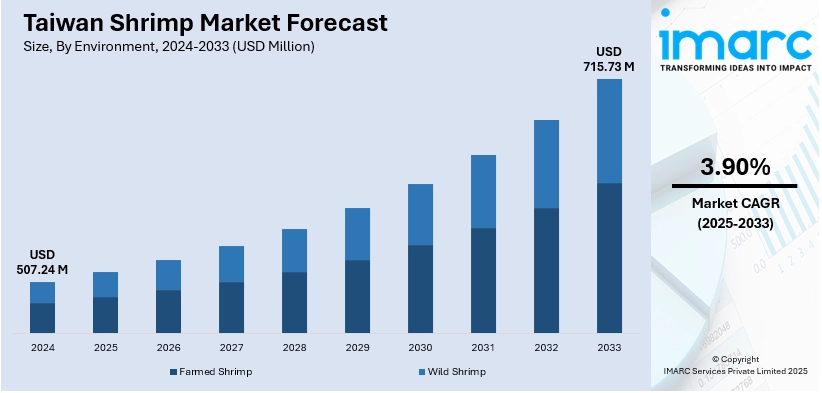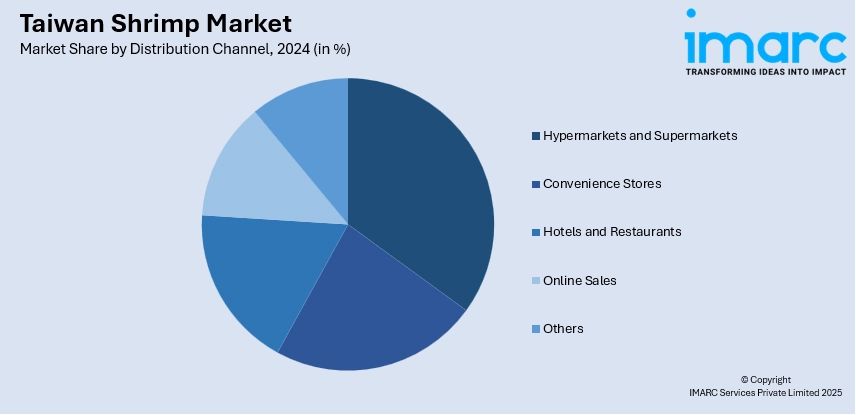
Taiwan Shrimp Market Size, Share, Trends and Forecast by Environment, Species, Shrimp Size, Distribution Channel, and Region, 2025-2033
Taiwan Shrimp Market Overview:
The Taiwan shrimp market size reached USD 507.24 Million in 2024. The market is projected to reach USD 715.73 Million by 2033, exhibiting a growth rate (CAGR) of 3.90% during 2025-2033. The market is expanding due to rising demand for sustainable seafood and advancements in farming technology. Innovations like recirculating aquaculture systems (RAS) and automation are improving production efficiency, helping Taiwan meet global demand and strengthen the Taiwan shrimp market share.
|
Report Attribute
|
Key Statistics
|
|---|---|
|
Base Year
|
2024 |
|
Forecast Years
|
2025-2033
|
|
Historical Years
|
2019-2024
|
| Market Size in 2024 | USD 507.24 Million |
| Market Forecast in 2033 | USD 715.73 Million |
| Market Growth Rate 2025-2033 | 3.90% |
Taiwan Shrimp Market Trends:
Sustainability Fuels Shrimp Industry Expansion
Taiwan shrimp market growth is strongly driven by expanding demand for sustainably farmed seafood. As consumers become more environmentally and ethically conscious, there has been considerable movement towards responsibly farmed shrimp. This is motivating Taiwanese shrimp producers to adopt more sustainable practices in production, including using environmentally friendly feed, reducing chemicals usage, and tracing products. Home-based shrimp farmers are also investing in emerging farming technology, such as recirculating aquaculture systems (RAS), that conserve water and lower waste. This allows them to meet growing consumer demand for better quality and more environmentally friendly seafood. The government of Taiwan has also supported these initiatives through policy actions targeting sustainable aquaculture processes as well as the marketing of the country's shrimp globally. These initiatives have assisted in broadening market prospects for Taiwanese shrimp growers in local and international markets. With continued increasing demand for sustainable seafood worldwide, Taiwan's shrimp industry is well positioned to meet these demands for long-term market growth. Taiwan is therefore increasingly becoming more prominent as a leading Asia exporter of shrimp produced sustainably.

To get more information on this market, Request Sample
Technological Advancements Improve Production Efficiency
Technological advancements are contributing significantly towards increasing Taiwan's shrimp farming industry in efficiency and productivity. As the Taiwan shrimp market grows, farmers are increasingly depending on automation and smart farming methods to improve manufacturing. Technologies such as automated feeders, water quality monitoring equipment, and real-time shrimp growth monitoring are helping farmers achieve higher yields and reducing labor costs. These lines of technology also enable enhanced shrimp health and farm condition control, leading to higher product quality and more consistent output. Additionally, the application of digital tools in aquaculture allows farmers to better monitor and control environmental parameters such that the shrimp are cultivated under optimal conditions. This has been made possible by investments from the private sector and government subsidies supporting industry efficiency and sustainability. In addition, Taiwanese shrimp farmers are discovering additional uses for such new systems as RAS and biofloc, reducing water wastage and further decreasing the environmental footprint. As these technologies are utilized more and more, Taiwan's shrimp industry can look forward to continued growth, producing for rising global demand while maintaining low costs of production and ecological impact.
Taiwan Shrimp Market Segmentation:
IMARC Group provides an analysis of the key trends in each segment of the market, along with forecasts at the country and regional level for 2025-2033. Our report has categorized the market based on environment, species, shrimp size, and distribution channel.
Environment Insights:
- Farmed Shrimp
- Wild Shrimp
The report has provided a detailed breakup and analysis of the market based on the environment. This includes farmed shrimp and wild shrimp.
Species Insights:
- Penaeus Vannamei
- Penaeus Monodon
- Macrobrachium Rosenbergii
- Others
The report has provided a detailed breakup and analysis of the market based on the species. This includes penaeus vannamei, penaeus monodon, macrobrachium rosenbergii, and others.
Shrimp Size Insights:
- <21
- 21-25
- 26-30
- 31-40
- 41-50
- 51-60
- 61-70
- >70
The report has provided a detailed breakup and analysis of the market based on the shrimp size. This includes <21, 21-25, 26-30, 31-40, 41-50, 51-60, 61-70, and >70.
Distribution Channel Insights:

- Hypermarkets and Supermarkets
- Convenience Stores
- Hotels and Restaurants
- Online Sales
- Others
A detailed breakup and analysis of the market based on the distribution channel have also been provided in the report. This includes hypermarkets and supermarkets, convenience stores, hotels and restaurants, online sales, and others.
Regional Insights:
- Northern Taiwan
- Central Taiwan
- Southern Taiwan
- Eastern Taiwan
The report has also provided a comprehensive analysis of all the major regional markets, which include Northern Taiwan, Central Taiwan, Southern Taiwan, and Eastern Taiwan.
Competitive Landscape:
The market research report has also provided a comprehensive analysis of the competitive landscape. Competitive analysis such as market structure, key player positioning, top winning strategies, competitive dashboard, and company evaluation quadrant has been covered in the report. Also, detailed profiles of all major companies have been provided.
Taiwan Shrimp Market News:
- April 2025: Honduras sought to explore new markets, including Taiwan, for its declining whiteleg shrimp exports. After shifting diplomatic recognition to China, shrimp exports fell by 67%, pushing Honduras to address sanitary issues and expand access, impacting the global shrimp trade.
Taiwan Shrimp Market Report Coverage:
| Report Features | Details |
|---|---|
| Base Year of the Analysis | 2024 |
| Historical Period | 2019-2024 |
| Forecast Period | 2025-2033 |
| Units | Million USD |
| Scope of the Report |
Exploration of Historical Trends and Market Outlook, Industry Catalysts and Challenges, Segment-Wise Historical and Future Market Assessment:
|
| Environments Covered | Farmed Shrimp, Wild Shrimp |
| Species Covered | Penaeus Vannamei, Penaeus Monodon, Macrobrachium Rosenbergii, Others |
| Shrimp Sizes Covered | <21, 21-25, 26-30, 31-40, 41-50, 51-60, 61-70, >70 |
| Distribution Channels Covered | Hypermarkets and Supermarkets, Convenience Stores, Hotels and Restaurants, Online Sales, Others |
| Regions Covered | Northern Taiwan, Central Taiwan, Southern Taiwan, Eastern Taiwan |
| Customization Scope | 10% Free Customization |
| Post-Sale Analyst Support | 10-12 Weeks |
| Delivery Format | PDF and Excel through Email (We can also provide the editable version of the report in PPT/Word format on special request) |
Key Questions Answered in This Report:
- How has the Taiwan shrimp market performed so far and how will it perform in the coming years?
- What is the breakup of the Taiwan shrimp market on the basis of environment?
- What is the breakup of the Taiwan shrimp market on the basis of species?
- What is the breakup of the Taiwan shrimp market on the basis of shrimp size?
- What is the breakup of the Taiwan shrimp market on the basis of distribution channel?
- What is the breakup of the Taiwan shrimp market on the basis of region?
- What are the various stages in the value chain of the Taiwan shrimp market?
- What are the key driving factors and challenges in the Taiwan shrimp market?
- What is the structure of the Taiwan shrimp market and who are the key players?
- What is the degree of competition in the Taiwan shrimp market?
Key Benefits for Stakeholders:
- IMARC’s industry report offers a comprehensive quantitative analysis of various market segments, historical and current market trends, market forecasts, and dynamics of the Taiwan shrimp market from 2019-2033.
- The research report provides the latest information on the market drivers, challenges, and opportunities in the Taiwan shrimp market.
- Porter's Five Forces analysis assists stakeholders in assessing the impact of new entrants, competitive rivalry, supplier power, buyer power, and the threat of substitution. It helps stakeholders to analyze the level of competition within the Taiwan shrimp industry and its attractiveness.
- Competitive landscape allows stakeholders to understand their competitive environment and provides an insight into the current positions of key players in the market.
Need more help?
- Speak to our experienced analysts for insights on the current market scenarios.
- Include additional segments and countries to customize the report as per your requirement.
- Gain an unparalleled competitive advantage in your domain by understanding how to utilize the report and positively impacting your operations and revenue.
- For further assistance, please connect with our analysts.
 Request Customization
Request Customization
 Speak to an Analyst
Speak to an Analyst
 Request Brochure
Request Brochure
 Inquire Before Buying
Inquire Before Buying




.webp)




.webp)












